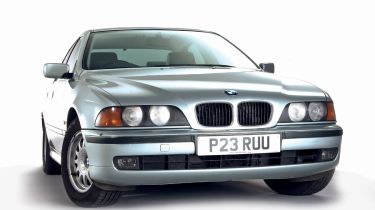BMW 5-Series
It was a class leader in its day, but is BMW’s previous generation model still worth buying used? We reveal all
Is this the world’s best second-hand car? Widely acclaimed when it made its debut 11 years ago, BMW’s E39 5-Series has grown old gracefully.
Replaced in 2003, it’s still a classy model, with a range of petrol and diesel engines, plus four-door and Touring estate bodies. There’s even the 400bhp M5 – the daddy of fast saloons.
How much?
For only £2,000, you can get an early 1996 N-reg 520i with well over 100,000 miles. Spend £5,000, and there’s a choice of better condition high-milers in low specs. A 1999 T-reg 530d diesel is more, with a sub-100,000-mile car closer to £7,000. SE or Sport specs, autos and estates add £1,000 to the price.
For a quality model, spend more than £10,000; pay £15,000 and you can cherry-pick the best 02 and 03-platers. Low-mile 530i and 540i saloons and the 525d and 530d four-door and Touring can cost £17,000, but the M5 is a further £5,000.
Running costs
There are three basic levels of main dealer check-up on the 5-Series: Oil service, Inspection I and Inspection II. Intervals are monitored by an on-board ‘traffic light’ system, and will normally be at 10,000 miles or once a year. You pay about £220 for an oil service at a franchise. Inspection I is around £300 and Inspection II £400 – all include parts and labour.
Used - available now

2018 BMW
5 Series
31,966 milesAutomaticDiesel2.0L
Cash £17,200
2020 BMW
5 Series
51,034 milesAutomaticPetrol2.0L
Cash £16,606
2020 BMW
5 Series
50,147 milesAutomaticDiesel2.0L
Cash £22,587
2023 BMW
5 Series
15,584 milesAutomaticPetrol2.0L
Cash £27,240Yet don’t ignore the many reputable independent brand specialists, whose prices should at least match those of the dealers. Fuel economy on all but the performance petrol models averages more than 25mpg, and if driven sedately, wear and tear on both tyres and brakes can be kept to a minimum. A catalytic converter costs more than £1,500.
What to look for
Legendary build quality makes the 5-Series a top choice, but as with any big exec, repairs can be costly if things go wrong. A full service history is vital to ensure that the coolant has been changed at least every three years.
Early models had issues with radiators, water pumps and premature bore wear. Radiators and thermostats can play up if the fan cuts in soon after start-up. Water pump failure – possibly a design fault – can occur on older cars. It even affects low-milers, so check whether it’s been replaced.
Checklist
Clutch: if you’re considering a manual model, look out for clutch wear. Juddering when pulling away is a tell-tale sign. Knock £400 off the price for a new clutch.
Engines: overheating, even for only short periods, can seriously damage
a 5-Series powerplant. Always check coolant levels, and look for oil deposits in the tank.
Dashboard: make sure the digital displays are visible and that all warning lights come on and then go off on start-up. Ill-fitting trim could also signal previous difficulties.
Gearbox: a leak in the oil cooler under the radiator can damage the gearbox. So with the engine off and cold, feel under the radiator for traces of oil. A repair will cost £300.
Alternatives
An obvious candidate is Mercedes’ E-Class (from 1995 to 2003), which offers a comfortable cabin and a massive estate. But it’s not as involving to drive as the 5-Series, and pre-1999 diesels can be noisy. Audi’s A6 is the other contender. Built from 1997 to 2004, it blends superb quality and understated looks, but is let down by inferior petrol engines and comfort.
Verdict
Great styling, a cosseting interior and best-in-class dynamics make the 5 a superb option. Supply is plentiful, and many have full histories, so a patient search could net you a car capable of many years’ service. A four-star Euro NCAP crash test rating (the highest level before the fifth star was added), plus a standard alarm and immobiliser, ensures the 5-Series isn’t far off modern levels of safety and security.
There are no bodywork issues, but older petrol engines need checking thoroughly. As always, a full history is crucial, but if you budget for regular servicing and above average running costs, you won’t be disappointed.
Recalls
JUL 1999: Auto gearbox on 535i can lock up.
DEC 1999: Brake light fault on Sept-Oct 1999 models.
NOV 2001: Cuts in tyre sidewalls on cars produced from Sept-Oct 2001 with Continental rubber.
NOV 2001: Risk of radiator cooling fan failure on diesels and V8s built from Nov 2000 to Sept 2001.
JAN 2002: Same problem as above on six-cylinder petrol models made from January to August 2001.
FEB 2002: Loose suspension bearing on all Nov 2001 cars.
NOV 2003: Unintentional deployment of airbag while
stationary on models built from Jan-Aug 2001.
MAR 2004: Possible inability to clutch or de-clutch on all manual cars made from June 2001 to July 2002.
DEC 2004: Heated seat fault on models from Sept 2002 on.







